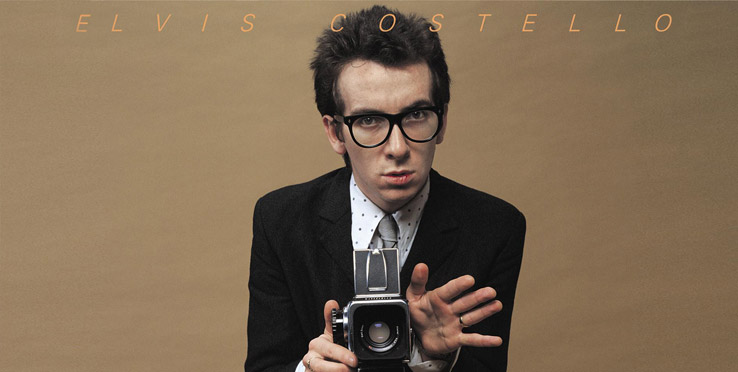It might have been easy to overlook an album like This Year’s Model early on. After all, here was a set of songs that typified the insurgent attitude of punk rock in its ignominious heyday. It was the work of a petulant young upstart clearly determined to upset the pop cart — and possibly the pop charts — through a turbulent approach that turned its back on pop precedent. Early on, it came across as an intimidating affair, bolstered by songs that seemed to affirm an angry, nihilistic point of view. Indeed, entries such as “No Action,” “Radio, Radio,” “Lip Service,” and “(I Don’t Want To Go To) Chelsea” took broad swipes at antagonists real and imagined, and with them, society at large and the mores that it imposed. Costello himself was the perfect outcast, a gawky persona in Buddy Holly glasses who seemed the very antithesis of the rock star ideal, a performer who seemed to have no intention of embracing his audience, but rather to further isolate them, if not from himself, then certainly from their current environs. After the free fall dissolution of the harmony and idealism of the ‘60s, This Year’s Model served as a reminder of the harsh realities and disingenuous platitudes the succeeding decade had ushered in in its place.
Nevertheless, for all its gloom and downcast pontificating, This Year’s Model did provide some promise. Only Costello’s second album overall — and the first with his remarkable new band, the Attractions (although they weren’t given the equal billing they deserved) — it heralded the continuing rise of an artist who had quickly established himself as an indelible presence, one capable of not only writing and recording great songs, regardless of genre, but inspiring others to do the same. (Graham Parker, take note!) Despite his determination to paint outside the lines, first and foremost Costello was capable of crafting great songs, flush with attitude, aptitude and, in most cases, the amplitude that all but assured immortality. Gone was the momentary self-pity of “Allison” from the first album. In it’s place was a new set of rallying cries, those garnered from the likes of “No Action,” “Pump It Up,” “Hand in Hand” and “This Year’s Girl.” They were lean yet muscular, filled with a particular tension and tenacity that ensured an immediate visceral appeal.
Likewise, the band’s flirtation with reggae rhythms and Costello’s take on Dylan-esque wordplay (which even extended to a title like “You Belong To Me,” a possible reference to the Bobster’s “She Belongs To Me”), showed this was a man and a band that had already outgrown the standard punk precepts and advanced to a particular pedigree all their own. “I don’t wanna kiss you/I don’t wanna touch/I don’t wanna see you/’Cause I don’t miss you that much,” Costello snarls on “No Action,” intersecting the same avenues of separation and alienation Dylan referred to in “Positively 4th Street” (“No, I do not feel that good/When I see the heartbreaks you embrace”)
At some point in their evolution, only a few great artists are able to outgrow their marginal trappings, elevate themselves beyond their early influences and exercise their ambitions to become something greater and more than the product of their times. Costello accomplished that early on with This Year’s Model and he was all the more remarkable for being able to do so at such an early, formative point in his still evolving career. It served as the solid foundation for a brilliant career that’s still evolving to this very day, one that shook the punk stereotype even while retaining its freewheeling everything-goes attitude, and eagerly embraced new musical spheres — rock (of course), country, adult easy listening, Americana and practically everything in between. It allowed Costello to become an equal iconic partner on the ultimate musical plateau, positioning him comfortably alongside Dylan, Emmylou Harris, Burt Bacharach, the Grateful Dead and all the other gatekeepers of modern music.
Happily then, its legacy gives testimony to that distinction. Despite the fact This Year’s Model barely scraped the U.S. top thirty (although it did manage to make it to number four on the British charts), in retrospect, it’s garnered any number of impressive kudos. It was voted the best album of the year in The Village Voice Pazz & Jop critics poll. In 2000, Q magazine placed it at number 82 in its list of the 100 Greatest British Albums Ever. In 1987, Rolling Stone magazine ranked it number 11 on its list of the best albums of 1967–1987. In 2003, the album was ranked number 98 on Rolling Stone magazine’s list of The 500 Greatest Albums of All Time. Perhaps most telling of all is the fact it’s been re-released three times, each with ample bonus tracks to justify its reacquisition.
Thirty-six years after its inception, This Year’s Model became a model for practically every year that followed. If Costello is considered rock royalty, and damn well he ought to be, then this album in particular provided the keys to his kingdom.
– Lee Zimmerman
Blurt, American Songwriter, M Music & Musicians, New Times, Goldmine, No Depression,
Country Standard Time, Elmore, Relix, CBS Watch, Bluegrass Situation, SyndicatedNews.NET

